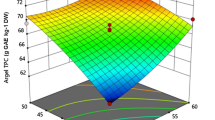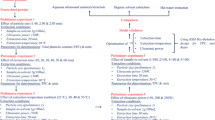Abstract
The ultrasound-assisted extraction was studied to improve the recovery of antioxidants from spent espresso coffee ground (SECG). The response surface methodology and the desirability approach were used to study and define the best recovery conditions in terms of time length of ultrasound (US) pulse, the extraction time and methanol/water mass ratio. The methanol/water mass ratio was the most important variable followed by the length of US pulse. Phenols between 19.29 and 24.95 mg GAE/g and antioxidant capacity from 134.90 to 174.73 μmol Trolox/g were recovered. A methanol/water ratio of 1.25, US pulse of 4 min and treatment time of 60 min enabled to reach a maximum desirability of 0.903. Through these conditions, an antioxidant activity of 172 μmol Trolox/g SECG and phenolic content of 24 mg GAE/g SECG were recovered. Contrarily, without US pulse a desirability value of only 0.605 could be obtained. This suggests that ultrasound-assisted extraction improves the recovery of antioxidants from SECG enabling to reduce of the methanol consumption and/or the treatment time.








Similar content being viewed by others
References
Galanakis CM (2012) Recovery of high added-value components from food wastes: conventional, emerging technologies and commercialized applications. Trends Food Sci Technol 26:68–87
ICO International Coffee Organization (2009) Total coffee production of exporting countries, London (UK). www.ico.org/trade_statistics.asp. Accessed 20 June 2016
Zuorro A, Lavecchia R (2013) Influence of extraction conditions on the recovery of phenolic antioxidants from spent coffee grounds. Am J Appl Sci 10:478–486
Mussatto SI, Ballesteros LF, Martins S, Teixeira JA (2011) Extraction of antioxidant phenolic compounds from spent coffee grounds. Sep Purif Technol 83:173–179
Bravo J, Monente C, Juaniz I, Paz De Pena M, Cid C (2013) Influence of extraction process on antioxidant capacity of spent coffee. Food Res Int 50:610–616
Yen WJ, Wang BS, Chang LW, Duh PD (2005) Antioxidant properties of roasted coffee residues. J Agric Food Chem 53:2658–2663
Brezová V, Slebodovà A, Stasko A (2009) Coffee as a source of antioxidants: an EPR study. Food Chem 114:859–868
Rawel HM, Kulling SE (2007) Nutritional contribution of coffee, cacao and tea phenolics to human health. J Verbrauch Lebensm 2:399–406
Ludwig IA, Clifford MN, Lean MEJ, Ashihara H, Crozier A (2014) Coffee: biochemistry and potential impact on health. Food Funct 5(8):1695–1717
Jiménez-Zamoraa A, Pastorizab S, Rufiàn-Henaresa JA (2015) Revalorization of coffee by-products. Prebiotic, antimicrobial and antioxidant properties. Food Sci Technol LEB 61:12–18
Galanakis CM (2015) Food waste recovery. Processing technologies and industrial. Elsevier, London
Galanakis CM (2013) Emerging technologies for the production of nutraceuticalsfrom agricultural by-products: a viewpoint of opportunities and challenges. Food Bioprod Process 91:575–579
Rajkumar P, Kailappan R, Viswanathan R, Raghavan GSV, Ratti C (2007) Foam mat drying of alphonso mango pulp. Dry Technol 25:357–365
Balachandran S, Kentish E, Mawson R, Ashokkumar M (2006) Ultrasonic enhancement of the supercritical extraction from ginger. Ultrason Sonochem 13:471–479
Kamaljit V, Raymond M, Lioyd S, Darren B (2008) Applications and opportunities for ultrasound assisted extraction in the food industry-A review. Innov Food Sci Emerg Technol 9(2):161–169
Xia T, Shi S, Wan X (2006) Impact of ultrasonic-assisted extraction on the chemical and sensory quality of tea infusion. J Food Eng 74:557–560
Bimakr M, Rahaman RA, Taip FS, Ganjloo A (2012) Optimization of Ultrasound-assisted extraction of crude oil from Winter melon (Banincasa hispida) Seed using response surface methodology and evaluation of its antioxidant activity, total phenolic content and fatty acid composition. Molecules 10:11748–11762
Pan Z, Qu W, Atungulu MH, McHugh TH (2012) Contonuous and pulsed ultrasound-assisted extractions of antioxidants from pomegranate peel. Ultrason Sonochem 19:365–372
Knorr D, Zenker M, Heinz V, Lee DU (2004) Applications and potential of ultrasonics in food processing. Trends Food Sci Technol 15:261–266
Chen F, Sun Y, Zhao G, Liao X, Hu X, Wu J, Wang Z (2007) Optimization of ultrasound-assisted extraction of anthocyanins in red raspberries and identification of anthocyanins in extract using high-performance liquid chromatography-mass spectrometry. Ultrason Sonochem 14:767–778
Herrera MC, Luque De Castro MD (2005) Ultrasound-assisted extractionof phenolic compounds from strawberries prior to liquid chromatographic separation and photodiode arry ultraviolet detection. J Chromatogr A 1100:1–7
Roselló-Soto E, Barba FJ, Parniakov O, Galanakis CM, Lebovka N, Grimi N, Vorobiev E (2015) High voltage electrical discharges, pulse electric field and ultrasound assisted extraction of protein and phenolic compounds from olive kernel. Food Bioprod Technol 8:885–894
Severini C, Ricci I, Marone M, Derossi A, De Pilli T (2015) Changes in aromatic profile of espresso coffee as a function of grinding grade and extraction time: a study by electronic nose system. J Agric Food Chem 63:2321–2327
Severini C, Derossi A, Fiore AG, De Pilli T, Alessandrino O, Del Mastro A (2015) How the variance of some extraction variables may affect the quality of espresso coffees served at coffee shop? J Sci Food Agric. doi:10.1002/jsfa.7472
Box GEP, Hunter JS, Hunter WG (2005) Statistics for experimenters: Design, Innovation and Discovery, 2nd edn. John Wiley & Sons, Hoboken
Singleton VL, Rossi JA (1965) Colorimetry of total phenolics with phosphomolybdic-phosphotungstic acid reagents. Am J Enol Viticu 16:144–158
Brands W, Cuvelier ME, Breset C (1995) Use of a free radical method to evaluate antioxidant activity. LWT Food Sci Technol 28:25–30
Vignoli JA, Bassoli DG, Benassi MT (2011) Antioxidant activity, polyphenols, caffeine and melanoidins in soluble coffee: the influence of processing conditions and raw material. J Food Chem 124:863–868
Derringer G, Suich R (1980) Simultaneous optimization of several response variables. J Qual Technol 12:214–218
Islam MA, Alam MR, Hannan MO (2012) Multiresponse optimization based on statistical response surface methodology and desirability function for the production of particleboard. Compos Part B Eng 43:861–868
Derossi A, Severini C, Mastro Del, De Pilli T (2015) Study and optimization of osmotic dehydration of cherry tomatoes in complex solution by response surface methodology and desirability approach. LWT Food Sci Technol 60:641–648
Wong WH, Lee WX, Ramanan RN, Tee LH, Kong KW, Galanakis CM, Sun J, Prasad KN (2015) Two level half factorial design for the extraction of phenolics flavonoids and antioxidants recovery from palm kernel by-product. Ind Crops Prod 63:238–248
Hecimovic I, Belscak- Cvitanovic A, Horzic D, Komes D (2011) Comparative study of polyphenols and caffeine in different coffee varieties affected by the degree of roasting. Food Chem 129:991–1000
Lopez-Galiela I, de Pena Paz, Cid C (2008) Application of multivariate analysis to investigate potential antioxidants in conventional and torrefacto roasted coffee. Eur Food Res Technol 227:141–149
Barba FJ, Galanakis CM, Esteve MJ, Frigola A, Vorobiev E (2015) Potential use of pulsed electric technologies and ultrasounds to improve the recovery of high added value compounds from blackberries. J Food Eng 167:38–44
Liu FF, Ang CYW, Springer D (2000) Optimization of extraction conditions for active components in Hypericum perforatum using response surface methodology. J Agric Food Chem 48:3364–3371
Do Kim, Lee KW, Lee HJ, Lee CY (2002) Vitamin C equivalent antioxidant capacity (VCEAC) of phenolic phytochemicals. J Agric Food Chem 50:3713–3717
Deng GF, Lee N, Kim YH, Lee CH, Hong SP, Jeon YW, Kim YE (2015) Optimization of Ultrasound-assisted extraction of natural antioxidants from sugar apple (Annona squamosa L.) peel using response surface methodology. Molecules 20:20448–204459
Lee LS, Lee N, Kim YH, Lee CH, Hong SP, Jeon YW, Kim YE (2013) Optimization of ultrasonic extraction of phenolic antioxidants from green tea using response surface methodology. Molecules 18:13530–13545
Ghafoor K, Choi YH (2009) Optimization of ultrasound-assisted extraction of phenolic compounds and antioxidants from grape peel through response surface methodology. J Korean Soc Appl Biol Chem 52(3):295–300
Author information
Authors and Affiliations
Corresponding author
Ethics declarations
Conflict of interest
The authors declare that they have no conflict of interest.
Compliance with ethics requirements
This article does not contain any studies with human or animal subjects.
Rights and permissions
About this article
Cite this article
Severini, C., Derossi, A. & Fiore, A.G. Ultrasound-assisted extraction to improve the recovery of phenols and antioxidants from spent espresso coffee ground: a study by response surface methodology and desirability approach. Eur Food Res Technol 243, 835–847 (2017). https://doi.org/10.1007/s00217-016-2797-7
Received:
Revised:
Accepted:
Published:
Issue Date:
DOI: https://doi.org/10.1007/s00217-016-2797-7




